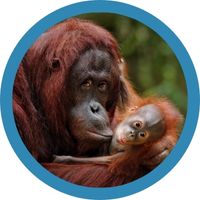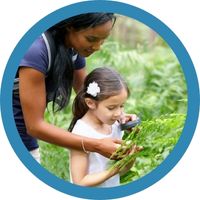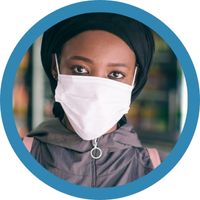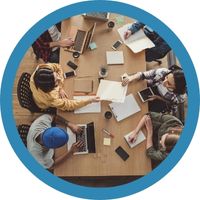This 6th grade unit on weather, climate, and water cycling is broken into four separate lesson sets. In the first two lesson sets, students explain small-scale storms. In the third and fourth lesson sets, students explain mesoscale weather systems and climate-level patterns of precipitation. Each of these two parts of the unit is grounded in a different anchoring phenomenon.
The unit starts out with anchoring students in the exploration of a series of videos of hailstorms from different locations across the country at different times of the year. The videos show that pieces of ice of different sizes (some very large) are falling out of the sky, sometimes accompanied by rain and wind gusts, all on days when the temperature of the air outside remained above freezing for the entire day. These cases spark questions and ideas for investigations, such as investigating how ice can be falling from the sky on a warm day, how clouds form, why some clouds produce storms with large amounts of precipitation and others don’t, and how all that water gets into the air in the first place.
The second half of the unit is anchored in the exploration of a weather report of a winter storm that affected large portions of the midwestern United States. The maps, transcripts, and video that students analyze show them that the storm was forecasted to produce large amounts of snow and ice accumulation in large portions of the northeastern part of the country within the next day. This case sparks questions and ideas for investigations around trying to figure out what could be causing such a large-scale storm and why it would end up affecting a different part of the country a day later.
Weather, Climate and Water Cycling is aligned to the Next Generation Science Standards and is freely available for download. This unit is part of the OpenSciEd middle school science program. BSCS Science Learning lead a consortium of organizations and science education experts in the development of this three-year program for grades 6-8.
For a school district, the adoption of instructional materials is a costly investment with long-term impacts. This decision-making process is critically important because instructional materials can either support or inhibit improvements in teaching and learning.
Historically, the selection process can be as simple as an individual leafing through materials—sometimes referred to as a “thumb test”—or as intensive as a year-long process involving teams of teachers and administrators. BSCS Science Learning and its collaborators have designed the NextGen TIME program for districts that are prepared to make an investment in the process to go beyond mere selection of materials to planning for implementation in order to maximize the benefit of their instructional materials.
NextGen TIME is a suite of tools and processes designed for professional development of leaders at the state, district, and school levels. Over the course of the NextGen TIME program, teams of educators are guided through the evaluation, selection, and planning for implementation of materials that will help teachers enact the vision of the Next Generation Science Standards (NGSS) in their classrooms. All program tools are freely available.
This resource was developed in partnership with Achieve K-12 and Alliance at WestEd
and was funded by Carnegie Corporation of New York.
Do you teach geography, environmental science, or similar classes?
Try these free resources in your classroom today!

OpenSciEd Middle School
Freely available units on plate tectonics, natural hazards, ecosystems and biodiversity, climate change, and more.

Invitations to Inquiry with FieldScope
These 2-4 day lessons, using citizen and community science data sets and the FieldScope platform, aim to support middle and high school students in working with real-world data. Topics include invasive species, species range, light pollution, plastic pollution, plant phenology, water quality, and healthy streams and rivers.
Other programs you may like:

FieldScope and Citizen Science
The FieldScope platform allows for interactive mapping and graphing citizen and community science data (upper elementary to high school).

COVID-19 and Health Equity
These units focus on the social and scientific aspects of the COVID-19 virus (all levels).

Engineering in the Garden
This is a garden-based engineering unit in which students design trellises to support pea plants. Students consider how to design and build trellises that will stay stable and support peas as they climb (elementary).

Media & Health Literacy
The goal of these materials is to help students learn strategies that they can use to evaluate the health-related information that they see or hear in the media.